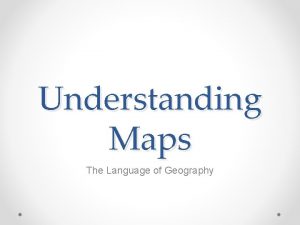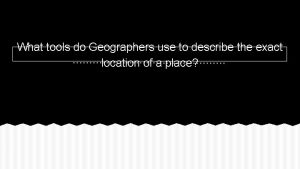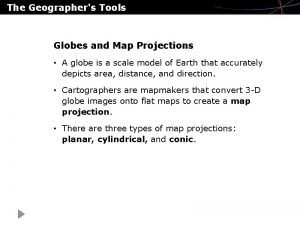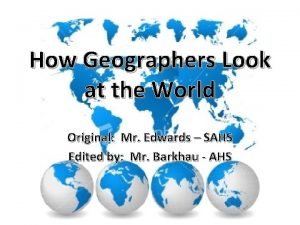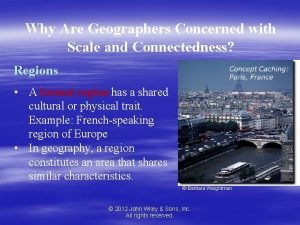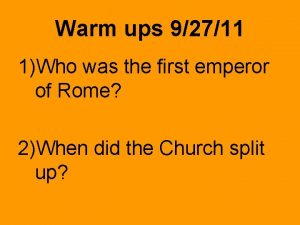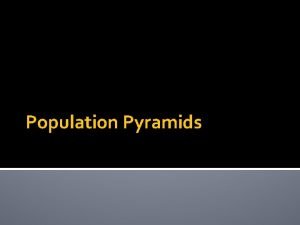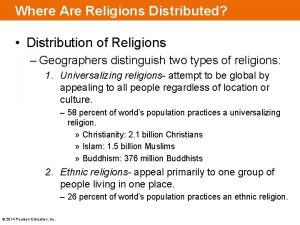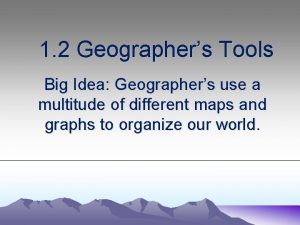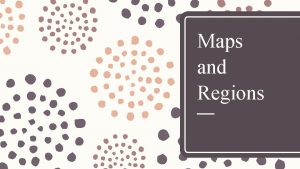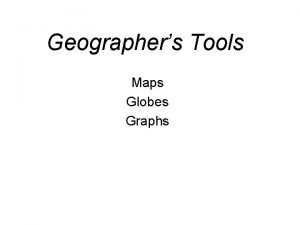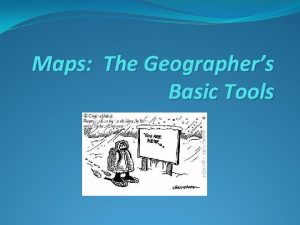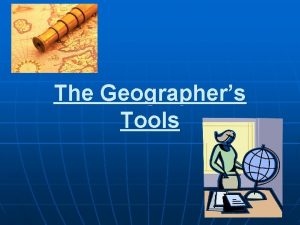The Geographers Tools Chapter 2 Section 2 Maps








- Slides: 8

The Geographer’s Tools Chapter 2 Section 2

Maps and Globes The oldest known map is a Babylonian clay tablet created about 2, 500 years ago. The tablet is about four inches high and shows the Babylonian world surrounded by water. Maps have grown much more complex since the beginning of man. Although they are still used for the same reason…finding location Globes: � a three-dimensional representation of the earth. Allows you to view the Earth as it travels through space. Since it is a sphere you can only see half of it at a time, and also is not very portable. Maps: � a two-dimensional graphic representation of selected parts of the Earth. � Easily portable. � Can be drawn to any scale that might be needed. � Although maps can become distorted since the Earth is flattened for the map. � A cartographer (mapmaker) can reduce distortion by presenting a map projection that presents a round earth on flat paper.

Types of Maps � There are three different types of maps that we use. � Reference Maps: one type of reference map is a topographic map, which is a representation of natural and man made features on earth. � Thematic Maps: emphasize specific kinds of information, such as climate or population density. � Navigational Maps: sailors and pilots use these maps. Used to navigate to and from specific areas.

Science of Mapmaking � Surveying: The first step in making a map is to complete a field survey. Surveyors observe, measure, and record what they see in specific areas. Most of this is done today by aerial photography or by satellites � The data gathered includes information such as elevation, differences in land cover, and variations in temperature. The information is then recorded and converted into a grey image that cartographers use data and computer software to construct maps.

Satellites � Geographers rely heavily on satellites to provide geographic data. Two of the best-known satellites are Landsat and GOES � Landsat is actually a series of satellites that orbit more than 100 miles above Earth. Each time a satellite makes an orbit of the earth it picks up data in 115 miles, allowing it to do an entire scan of earth in 16 days. � GOES or Geostationary Operational Environment Satellite is a weather satellite that flies in orbit with earths rotation. It always flies in the same area allowing it to take images of atmospheric conditions that are useful in forecasting weather.

Geographic Information Systems � Graphic Information Systems (GIS): the newest tool for geographers. It stores information about the world in a digital database. It has the ability to combine information from a variety of sources that allow the user to visualize the use of space in different ways. � Using the system, geographers must look at a problem and decide what types of geographic information would help them solve the problem. The info could include maps, aerial photos, satellite images, or other data. Geographers then add the information collected earlier and combine the two making a composite map.

Global Positioning System (GPS) � GPS was originally developed to help military forces know exactly where they were on the earths surface. � Uses a series of 24 satellites called Navstars, which beam information to the earth. The exact information, using longitude, latitude, altitude and time, is displayed on a hand-held receiver. � Today everyone uses it from drivers, hikers, explorers, and even pets have devices on them to determine their location.

Review �Terms: Globe, Map, Cartographer, Map Projection, Topographic Map, and GIS. �How does a globe show a region differently than a map? �What are three types of maps? �Questions 1 -5 Page 19 due tomorrow.
